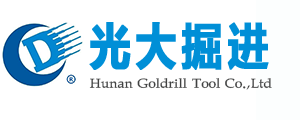
Factors affecting the efficiency of rock drilling tools
In addition to the correct choice of carbide grades, rock drilling efficiency is also affected by many factors, mainly the shape of the bit, rock hardness, compressed air pressure, powder discharge method, blasthole diameter and blasthole depth.
Bit shape
The shape of the bit directly affects the section of the blasthole. The blasthole sections of most drill bits are polygonal rather than round. Therefore, the polygonal cross section is formed by the side of the gun when the bit is pressed along its own axis. During the rock drilling process, the drill rod does not rotate with a fixed axis but swings freely in the blasthole. This situation can be seen in the actual supply as long as it is carefully observed. The shape of the bit is different, and the cross section of the blasthole obtained during rock drilling is also different.
The edge shape of the blasthole section is one plus the number of the cutting edge of the bit used. When the large-diameter bit ramite is used, the phenomenon that the hole shape is not round is more remarkable. If the hole shape is not round, it will increase the length of the eye and the length of the periphery, while the rock around the fundus is the most difficult to break. Therefore, it will affect the drilling speed to a large extent. The non-circular shape of the hole also hinders the normal rotation of the bit. For deep hole drilling, the impact is even greater, and even the twisting of the drill rod or the phenomenon of jamming may occur. Due to some of the effects of the hole shape, in recent years, research has begun and solutions have been sought. If the shape of the bit is changed, the thickness of the working blade portion is increased, and the wind pressure is increased. However, it has not been completely resolved and needs further study.
Rock performance
Rock properties that affect rock drilling speed are mainly viscosity, hardness and elasticity. The viscosity of a rock is the ability of a rock to resist breaking into small pieces. The viscosity of the rock is related to the composition and composition of the rock; the size and shape of the particles; the amount of the cement, the composition, and the degree of moisture content. Dense and homogeneous rock, the same viscosity in all directions, heterogeneous or layered rock, sticky in all directions
Sex is not the same. The hardness of the rock is also the same as the viscosity, which is determined by the connection force of the rock particles. However, the hardness of the rock is resistant to the ability of sharp tools to drill into it. The elasticity of a rock is the ability to restore its original shape and volume after the external force acting on the rock disappears. All rocks are elastic. The elasticity of the rock has a significant effect on the impact rock drilling.
Compressed air pressure
Compressed air pressure has a large effect on the rock drilling speed. As the compressed air pressure decreases, the relative supply rate of the rock drill decreases.
Several types of rock drills 01-30, 01-45, 01-38 and YT-25 used in China's current supply should have a working pressure of more than 5 atmospheres to ensure normal operation. Many mines have adopted measures to increase wind pressure to increase rock drilling speed. However, the general wind pressure is preferably between 5 and 8 atmospheres. If it is too high, damage to the parts and ducts of the rock drill will increase. If it is less than 5 atmospheres, the rock drilling speed will drop significantly. According to the test, the minimum consumption of compressed air during rock drilling is 7 atmospheres, and the work consumed per unit length of blasthole is the smallest at 6 to 6.5 atmospheres.
Rock dust removal
When rock is impacted, the formation of rock dust in the blasthole will greatly reduce the supply rate of the rock drill. Especially when drilling rock vertically or obliquely, if the accumulated rock powder is not removed in time, it will increase the repeated crushing and reduce. Rock drilling speed. There are two main methods for removing rock powder from the blasthole: the blowing method and the water washing method. The method of blowing powder in the air blowing method will increase the dust content in the air, which is harmful to the health of workers working underground. Now underground operations have been banned. A common method is to rinse with water. This method can not only effectively exclude rock powder, but also increase the rock drilling speed, increase the wear resistance of the rock drilling tool and significantly improve the working conditions. This method can ensure that the dust content under the well is below 0.2 mg.
Bare diameter
Increasing the diameter of the blasthole reduces the rate of rock drilling per unit time. By reducing the diameter, the rock drilling speed can be increased. When the diameter of the blasthole is increased from 40 mm to 60 mm, the rock drilling speed is more than doubled. On the other hand, the diameter of the blasthole increases, and accordingly a large-diameter pack is used. The diameter of the drug pack is increased, and the utilization of the blasthole can be improved, the explosive can be completely exploded, and the toxic nitrogen oxide content in the blasting product is reduced. According to the test, a 40 mm drug pack is used instead of the standard drug pack. When other blasting conditions are the same, the blasthole on the working surface can be reduced by about 33.3%, the blasthole utilization rate can be increased by 15%, the blasting material consumption can be reduced by 42%, and the explosive consumption is reduced. Reduce by 13%.
Small-diameter bits have been tested and promoted in some mines for some time, and some results have been obtained in different degrees, but they have not been fully promoted. The diameter of the drill heads currently used is still most commonly 40 to 43 mm, and the individual mines are 46 mm.
Blasthole depth
The depth of the blasthole has a significant impact on the speed of the tunneling and the cycle time of the job. The depth of the blasthole increases and the rock drilling speed decreases. When the blasthole reaches a certain depth, the loss of impact energy of the drill rod is also increased due to the elastic deformation of the drill rod and the friction of the blasthole wall. Changes in the depth of the blasthole cause changes in the rate of rock drilling. In rocks of different hardness, it is not the same. In harder rocks, the impact is small. Generally speaking, when the compressed air pressure is sufficient, the depth of the blasthole is below 3 to 3.5 meters, and the rock drilling speed does not change much. According to the test, in the different rock heads, the hardness of the blasthole and the rock drilling speed are tested when drilling with a cemented carbide bit.




